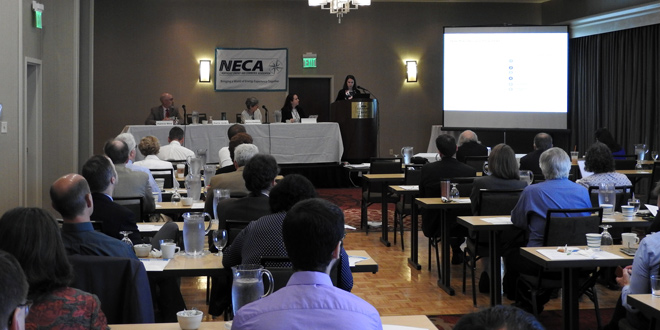By William Opalka
MARLBOROUGH, Mass. — New England states are moving ahead with their own greenhouse gas reduction programs while EPA’s Clean Power Plan remains in legal limbo.
At the Northeast Energy and Commerce Association Annual Environmental Conference on Wednesday, panelists said that the nine-state Regional Greenhouse Gas Initiative remains on course despite the U.S. Supreme Court’s decision in February to stay the federal plan pending legal challenges.
“We don’t have much in the way of travel to reach the Clean Power Plan targets under the current design of the final rule,” said Patricio Silva, a senior system planning analyst at ISO-NE. (See Northeast on Way to Compliance with Clean Power Plan.)
RGGI, which EPA has cited as a model, is currently committed to a 2.5% annual reduction in carbon emissions. But it undergoes program reviews every three years — including one now in progress — that could adjust targets.
The CPP seeks to reduce carbon emissions from the power sector by 32% below 2005 levels by 2030, with interim reductions required in 2022-2029.
While simple cycle gas turbines are exempt from the CPP, RGGI also includes all fossil units above 25 MW. EPA did not include simple cycle — or peaker — plants, reasoning that they run too infrequently to have a major impact on emission reductions. “That is an important distinction,” Silva said, calling it a sign of the RGGI states’ more aggressive carbon reduction goals.
According to the Energy Information Administration, ISO-NE’s carbon intensity was 1,037 pounds of CO2/MWh in 2015, which is projected to drop to 986 lbs/MWh by 2030, well within the CPP targets (1,305 lbs/MWh for existing fossil fuel-fired electric steam generating units and 771 lbs/MWh for existing natural gas combined cycle units), Silva said.
CPP Arguments in September

While the Supreme Court is likely to determine the CPP’s ultimate fate, the legal challenge is currently before the D.C. Circuit Court of Appeals (West Virginia v. EPA, No. 15-1363). In May, the D.C. Circuit rescheduled oral arguments from June 2 to Sept. 27, 2016, skipping an initial review by a three-judge panel and moving directly to an en banc hearing with nine of the circuit’s 11 active judges.
Carrie Jenks, a senior analyst with M.J. Bradley and Associates, said that while the CPP legal challenge may affect some states’ planning, the RGGI states have continued to plan for compliance, leading to key questions.
“RGGI [has to] decide if it would trade with states outside of its region, such as other PJM states, either at the start of the program or at a future date. RGGI states also need to consider what the CPP targets mean for the overall RGGI cap as the states undertake the RGGI program review, and how will such decisions may affect states outside of RGGI,” she said.
Nancy Seidman, assistant commissioner at the Massachusetts Department of Environmental Protection, credited EPA for recognizing the emission reductions achieved by the RGGI states. “We’ve done a lot and fortunately EPA considered that,” she said.
“What’s important now is, where do we want to go next? What are our goals for 2030 with or without the Clean Power Plan? And how does that mesh with states’ individual goals?” she said.





